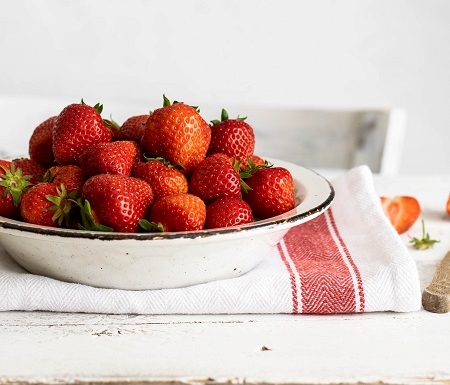
Strawberries are one of the most exciting of summer’s fruits. They are rewarding to grow at home, and this allows one to avoid the over-sized berries in the grocery store that often have the flavor of cardboard.
Versatile to grow, even apartment dwellers can have a happy little crop in limited space. The obviously named strawberry planters can be used to grow them, but they also grow well in hanging baskets and a variety of other containers. Hanging baskets from rafters of greenhouses is one way to maximize floor space, and once the weather is warm, they make a lovely porch decoration. Strawberries can also be grown as ground cover or in raised beds, for those lucky gardeners with plentiful space, but for our purposes, we’ll treat them as a container crop.
Day-neutral and everbearing strawberries are the best bet for gardeners short on space, though they produce smaller fruit than June bearing strawberries. These types send out fewer runners than June bearing varieties, helping them to be more compact. Additionally, these types continue to produce fruit well after June, allowing for an extended harvest. The performance of a specific variety depends closely on the region in which its grown. If a particular variety does not produce as well as had been hoped, it may pay to do a little more region-specific homework. Quinalt and Fresca strawberries produce no runners, which makes them ideal for pots. Tristar can grow in cooler climates and produces a very tasty berry.
Many gardeners remove the first few sets of flowers from their strawberry plants to encourage fruit set, doing so until some point in June, depending upon the gardening zone. One of the things that makes homegrown strawberries so much more delicious than their commercial cousins is the timing of the harvest. Strawberries are at their best when allowed to ripen on the plant, a day or two after they’ve gotten their color. There’s not a mathematical formula to determine when they’ve peaked, instead have a taste test, and trust your palate. Of course, the ripe berries bruise and smash easily; to pick them it’s better to snap the stem above the berry and avoid pulling on the fruit itself.
For the berries that make it into the kitchen, there is then the delightful question of their use. Sweet uses for strawberries are obvious and plentiful, yet they also can contribute an element of surprise to savory dishes. Certain things pair well with strawberries- their tangy sweetness in jam offsets the creamy saltiness of peanut butter, and their acidity contrasts with the richness of whipped cream, either as is or on top of a sweet scone or piece of pound cake. The simplest of fruit toppings for dessert or breakfast is made by slicing washed and hulled strawberries, then sprinkling them with granulated sugar. Left to rest in the refrigerator for an hour or two, this produces a gorgeous bright red syrup around the slices. However, they can also be sliced and added to a garden salad with a piece of grilled chicken or added to a fruit and pepper salsa.
Preserving strawberries is easy, with freezing and canning topping the list. However, if not treated properly, frozen strawberries can freeze into a lovely red brick, which is just fine if they are to be pureed upon their final use. To use the berries individually as in a smoothie, wash and hull them, then arrange them with a little space between them on a cookie sheet lined with parchment or wax paper. Once the berries are frozen, they can be moved to a bag or container. Strawberry jams and jellies are a welcome treat around midwinter and will be gladly received as gifts. Additionally, a serious canning session around midsummer can save you from running to the store for a jar of jelly for the year following.
This recipe is one we made at our house with some fantastic local berries. The measurements are inexact, but this salad can be made to serve just one or for a whole party, and it’s best eaten the same day.
Strawberry Salad
- A bowl of strawberries, washed hulled and sliced
- Mozzarella cheese – if ciliegine are available, they can be used whole, otherwise cut about 1/4 as much cheese as you have strawberries into small cubes
- A small handful of fresh basil, rolled and cut into chiffonade
- Balsamic vinegar
- Mix mozzarella cheese into strawberries in bowl gently, add basil. Drizzle balsamic vinegar over the top to moisten.
For a different flavor, try reducing the balsamic vinegar over a low heat until it’s thick and syrupy. This will allow you to drizzle it artfully over individual plates and brings out natural strawberry and banana flavors in the vinegar. Amy Ambrosius is a writer and budding gardener living deep in the heart of Texas with her family.
Related Articles & Free Email Newsletter Sign Up
How to Grow Upside Down Tomatoes in Five Gallon Buckets
How to Grow Vegetables and Fruit in a Hot Summer Greenhouse




Comment here